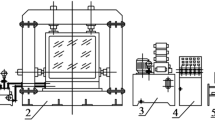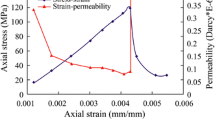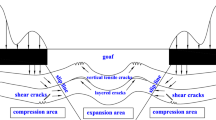Abstract
Based on the inducement mechanism of floor water-inrush by high confined water and rock nature, and aimed at establishing rock mass mechanical models, numerical simulation tests with FLAC3D are conducted to reproduce the formation and evolution of water-inrush channel advancing with workface in high water pressure mining. Numerical analysis results show that the volumetric strain of rock crack face is affected by the interaction between stress field and seepage field, which provides new knowledge on the formation and evolution characteristics of floor water-inrush channels under high pressure.
Similar content being viewed by others
Avoid common mistakes on your manuscript.
Mine water hazards always perplex and threaten the work safety of mining production in China. And due to the increasing of mining depth, the floor has to support growing hydraulic pressure from aquifer. In result, the number and the degree of water-inrush from floor present a rising trend (Li 1999). For the varieties of geological and hydrological conditions in different areas, the conditions of water-inrush can not be separated from the water source and rock mass (Niu 2008). So it is important to seriously consider their effects when water-inrush problems were studied.
There are many methods to study the mechanism of floor water-inrush. Among them the numerical techniques are widely applied. Feng et al. (2006) adopted the technology to simulate instability, fracture expanding and water-inrush under the mining conditions. The instability-failure process of the coal-bed floor due to confined water-inrush was simulated and analyzed (Yang et al. 2003). Li et al. (2009a, b) used numerical tests with FEM to investigate the initiation of fractures, activation of faults and formation of groundwater-inrush pathway with mechanical model for rock mass with faults in coal mining above confined aquifer. Zheng et al. (2000) established a coupling model of fluid flow and damage about water-inrush which was successfully applied into predicting water-inrush disasters of coal mine.
However, the processing formation and evolution of water-inrush channel were affected by the coupling effects of mining stress and high pressure water (Li et al. 2011). The above researches only consider the affection of mining stress, but ignore seepage characteristics of high pressure water source. In this paper, the evolution of plastic zone of floor failure was simulated and analyzed by Flac3D under coupling effects of mining stress and high pressure water.
1 Theory of Crack Evolution for Water-Inrush
In the coal seam exploitation process, mining activities break the balance of stress of the primary rock, cause the redistribution of stress of the stope and affect the integrity of floor rock mass and the extension of grown-in defects. The existence of the high pressure water makes a dynamic failure influence on water-resisting floor (Li et al. 2009a, b). In the process of mining, the floor rock would form miner flaw net. At the same time, the high pressure water would overcome the resistance from expansion and evolvement of jointed rock mass to form microcosmic progressive intrusion. And then it formed seepage passageway, which makes the flaw net full of water, as shown in Fig. 1. With the working face advanced, the mining-induced stress and high-pressure water sources constantly damage the stope floor to lead to floor displacement, for which such phenomena as “floor heave” and “crack seepage” take place, to further form water-inrush channels in the zone under their interaction to cause floor water-inrush accidents.
2 Research on Numerical Simulation of Floor Water-Inrush
2.1 Design of Numerical Model
With the destruction of floor in the processing of face advanced, the danger of mining coal under high water pressure was simulated and analyzed by Flac3D. By the changing of water-resisting floor’s natures and high water pressure, how the floor gradually destroys until forming water-inrush passageway was analyzed. Meanwhile through combining stress field and seepage field, its forming and expansion laws were analyzed.
In order to make the calculation accurate and convenient, according to symmetry principle, a quarter of the mining area was selected to simulate, as shown in Fig. 2 (Liu et al. 2004).
The FLAC3D software is utilized to build a three-dimensional model with the length of 80 m, width of 70 m, and height of 105 m. The model is divided into 37,632 elements, as well as 41,151 nodes. The sides of the model (the two on the X direction and the two on the Y direction) bind the displacement on the horizontal direction; its bottom is fixed; on the top of the model the uniform load is applied to simulate the weight of the overlying rock, for which the Mohr–Coulomb yield criteria is adopted. The coal seam is designed with the depth of 1200 m and the average unit weight of the overlying rock is 25 kN/m3, and as the result, the uniform load applied on the model is 29.25 MPa.
The rock mechanics parameters of the coal seam and each stratum in the simulation are shown in Table 1.
2.2 Designs of Simulation Schemes
Under the coupling effects of stress field and seepage field, the simulation content mainly includes two aspects. One is whether the destruction depth of floor and the progressive intrusion of high water pressure can link up or not. Another is the evolution features after linking up. So the study simulates the distribution and development of the destructive plastic zone of floor water-resisting layer through the whole mining process. According to the content, the specific plans are shown in Table 2.
2.3 Analysis of Simulation Results
In the numerical simulation, the full-mechanized caving mining was adopted. It would mine 5 m each time along the coal seam strike, and when the model balances, such mining is continued until the advance is completed.
2.3.1 Simulation Results of Scheme I
Simulation results of scheme I are shown in Fig. 3. It can be obtained the following conclusions.
-
1.
Under the conditions of stress field and seepage field coupling, the area above roof strata appeared plastic failure zone when the face advanced 10 m. And when the faces advanced 45 m, the maximum mining destructive depth of floor was 22.5 m, which was located at the middle of gob. And with working face continuously advanced, the destructive depth of floor kept stable and wouldn’t develop down. Under the effects of coal mining, water resisting layer appeared plastic failure zone at the lower interface with the action of water pressure while working face advanced 10 m. And the plastic zone continued evaluating upwards with the advancing of face. The maximum depth of plastic failure zone can reach to 7.5 m while working face advanced 55 m. In the late phase of advancing, the plastic failure zone of water resisting layer under the middle of gob greatly developed.
-
2.
In the whole process of mining, both the top and the bottom interface of water resisting layer had not appeared linking up. Complete strata of 10 m thickness existed in water resisting layer, which kept stable and had water separating capacity. So the water-inrush passageway hadn’t formed under the mining conditions.
2.3.2 Simulation Results of Scheme II
Simulation results of Scheme II are shown in Fig. 4. It can be obtained the following conclusions.
-
1.
When the workface advances to 40–45 m, the maximum mining destructive depth of floor strata was 27.5 m which was located at the middle of gob. At the same time, destructive depth of the bottom interface of water resisting layer can reach 7.5–10 m. When the face advanced 55 m, the height of plastic failure zone can reach 12.5 m. As the developing process of the bottom interface of plastic failure zone, the plastic failure zone of water resisting layer under rib, firstly developed upward.
-
2.
When the working face advances from 50 to 60 m, the plastic failure zone of water resisting layer occurred transfixion between the top and the bottom interface. So intact rock mass was destroyed and fail to resist water under the mining conditions. Furthermore, the water-inrush passageway had formed.
2.3.3 Simulation Results of Scheme III
Simulation results of Scheme III are shown in Fig. 5. It can be obtained the following conclusions.
-
1.
When the face advanced 40 m, the mining destructive depth of floor strata has reached to 30 m which was located at the middle of gob. With the advancing of faces, the destructive depth of floor kept stable and did not develop down. But the range of destruction expanded towards the direction of advancing.
-
2.
When the face advanced 40–45 m, the height of plastic failure zone can reach to 10 m. So the range expanded. When the face advanced 50 m, the height of plastic failure zone under the floor can reach 12.5 m. With the advancing of working face, the plastic zone continued expanding. When the face advanced from 50 to 55 m, the plastic zone started to extend to both sides and linked up with upper plastic zone. When the face advanced 60 m, the plastic zone located at the position of transfixion has tend to expand. At the same time, the whole lower plastic zone guided slightly rose. So with the advancing of the working face, if the passageway of water-inrush formed, its range would expand and its path would increase. It means that both the water irruption quantity and water irruption point would increase.
2.4 Comparative Analysis of Simulation Results
According to the different simulation results of three plans, change rules of the damaging depth of the coal seam floor and height of hydraulic water rise height under different conditions were achieved. Through comparative analysis, it can be obtained the following results.
-
1.
According to simulation results of the failure depth of floor and the hydraulic water rise height under water pressure of 6 MPa and 12 MPa, it can be seen that the failure depth of floor and the hydraulic water rise height is positively related to the water pressure. Furthermore, the destroyed depth of floor would increase under the coupling effects of seepage field and stress field.
-
2.
According to the change of aquifuge properties, if its tensile strength and the lithology are greater, the better its abilities of resist failure and water are. It means the properties of water-resisting layer affects the forming of seepage passageway including the formation time, channels size and location path.
-
3.
The formation process of water-inrush passageway is the result of coupling of seepage field and stress field. It is closely related to water pressure, the properties of water-resisting layer and the advancing distance of working face. And it is beneficial to form water-inrush passageway if the pressure of confined water is large and the properties of water-resisting layer is weak. And the formation time is short. Furthermore, the advancing distance of faces is relatively small at the moment. At invariable water pressure and properties of water-resisting layer, the larger the advancing distance of working face is, the more easily water-inrush passageway forms.
3 Conclusions
-
1.
The formation of the floor water-inrush channel was the processing of deformation failure for coal floor. It is a result of coupling effects of seepage field and stress field. In the whole process, the stress field changed for the affecting of mining. And the seepage field is related to water pressure resulting in the increase of failure depth of floor. Furthermore, seepage field and stress field can interact with each other through volumetric strain of rock fractures’ surface.
-
2.
Both the forming process of water-inrush passageway and evolution process are affected by water pressure and properties of water-resisting layer. If the water pressure is great, the properties of water-resisting layer are poor and advancing distance large, it will be more conducive to form passageway. After forming passageway, its size will gradually expand when advancing faces. And the evolution of plastic zone under the floor is stronger than the upper. The progressive intrusion range of confined water would gradually expand. And the water and water irruption path increase.
References
Feng QY, Yang TH, Yu QL et al (2006) Numerical simulation on water-inrush from the seam floor based on the coupled analysis of seepage and damage. J Saf Environ 6(3):1–4
Li BY (1999) “Down Three Zones” in the prediction of the water inrush from coalbed floor aquifer-theory, development and application. J Shandong Inst Min Technol Nat Sci 18(4):11–18
Li LC, Tang CN, Liang ZZ et al (2009a) Numerical analysis of pathway formation of groundwater inrush from faults in coal seam floor. Chin J Rock Mech Eng 28(2):290–297
Li LC, Tang CA, Li G et al (2009b) Damage evolution and delayed groundwater inrush from micro faults in coal seam floor. J Geotech Eng 31(12):1838–1844
Li LP, Li SC, Shi SS et al (2011) Water inrush mechanism study of fault activation induced by coupling effect of stress–seepage–damage. Chin J Rock Mech Eng 30(S1):3295–3304
Liu CL, Qi SW, Tong LQ et al (2004) Stability analysis of slope under earthquake with FLAC3D. Chin J Rock Mech Eng 23(16):2730–2733
Niu JL (2008) A study on coupling effect between rock and water in coal floor and safety mining technology under high underground pressure. China Coal Research Institute, Beijing, pp 19–25
Yang TH, Tang CN, Liu HY et al (2003) Numerical model of the instability-failure process of the coal-bed floor due to confined water inrush. J Geomech 9(3):281–288
Zheng SH, Zhu WS, Wang SF (2000) Study on the solid–fluid coupling in the coal minim above confined aquifers. Chin J Rock Mech Eng 19(4):421–424
Author information
Authors and Affiliations
Corresponding author
Additional information
Publisher's Note
Springer Nature remains neutral with regard to jurisdictional claims in published maps and institutional affiliations.
Rights and permissions
About this article
Cite this article
Li, T., Wang, C. Numerical Simulation Study on Formation and Evolution Process of Water-Inrush Channel in Floor Under High Water Pressure. Geotech Geol Eng 37, 3007–3012 (2019). https://doi.org/10.1007/s10706-019-00819-y
Received:
Accepted:
Published:
Issue Date:
DOI: https://doi.org/10.1007/s10706-019-00819-y









